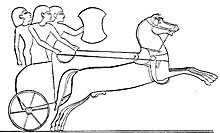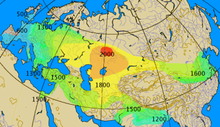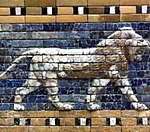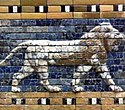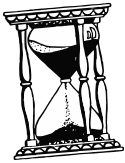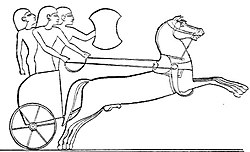Stridsvogn
Stridsvognen er den tidligste og enkleste form for hestevogn brugt i krig og fred af mange folkeslag i antikken. Oksekærrer blev bygget af urindoeuropæere og blev også bygget i Mesopotamien så tidligt som 3000 f.Kr. Den oprindelige stridsvogn var hurtig let åben og tohjulet trukket af to eller flere heste forspændt ved siden af hinanden. Vognen et gulv med en halvcirkelformet afskærmning forrest, som når op til taljen. Vognen blev styret af en vognstyrer og blev brugt i krigsførelse i bronze- og jernalderen. Vognen blev også brugt til rejser, optog, i turneringer og til væddeløb, efter at den blev overflødig til militære formål.
Se også
Eksterne henvisninger
| |||||||||||||||||||||||||||||||||||||||||||||||||||||||||
|
| Spire Denne historieartikel er en spire som bør udbygges. Du er velkommen til at hjælpe Wikipedia ved at udvide den. |
| Spire Denne artikel om militær er en spire som bør udbygges. Du er velkommen til at hjælpe Wikipedia ved at udvide den. |
Medier brugt på denne side
Forfatter/Opretter: by en:User:Dbachmann, Licens: CC BY-SA 3.0
Historical spread of the chariot. This map combines various classes of information, historical and archaeological. The 'isochrones' as given should not be considered more than rough approximations, give or take a century.
- red, 2000 BC: area of the earliest known spoke-wheeled chariots (Sintashta-Petrovka culture)
- orange, 1900 BC: extent of the Andronovo culture, expanding from its early Sintashta-Petrovka phase; spread of technology in this area would have been unimpeded and practically instantaneous
- yellow, 1800 BC: extent of the great steppes and semi-deserts of Central Asia, approximate extent of the early Indo-Iranian diaspora at that time. Note that early examples of chariots appear in Anatolia as early as around this time.
- light green, 1700 BC: unknown, early period of spread beyond the steppes
- green/cyan, 1600-1200 BC: the Kassite period in Mesopotamia, rise to notability of the chariot in the Ancient Near East, introduction to China, possibly also to the Punjab and the Gangetic plain (Rigveda) and E and N Europe (Trundholm Sun Chariot), assumed spread of the chariot as part of Late Bronze Age technology
- blue, 1000-500 BC: Iron Age spread of the chariot to W Europe by Celtic migrations
drawing from an egyptian relief,
Forfatter/Opretter: No machine-readable author provided. QuartierLatin1968 assumed (based on copyright claims)., Licens: CC BY-SA 3.0
Same as Image:Cibeles con Palacio de Linares al fondo.jpg, but I've cropped the image to focus on Cybele. The original is attributed to Mr. Tickle, the author of the work. QuartierLatin1968 02:09, 28 February 2006 (UTC)
